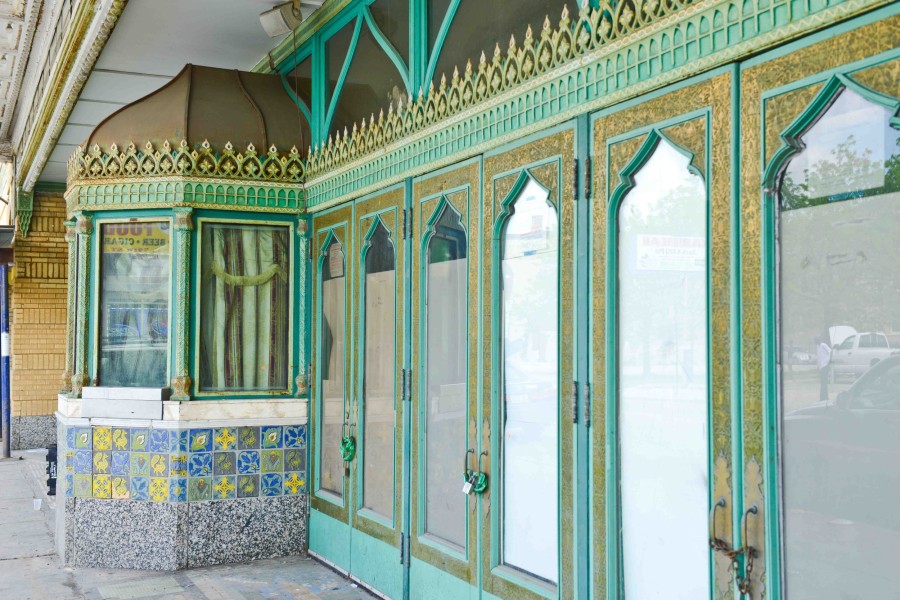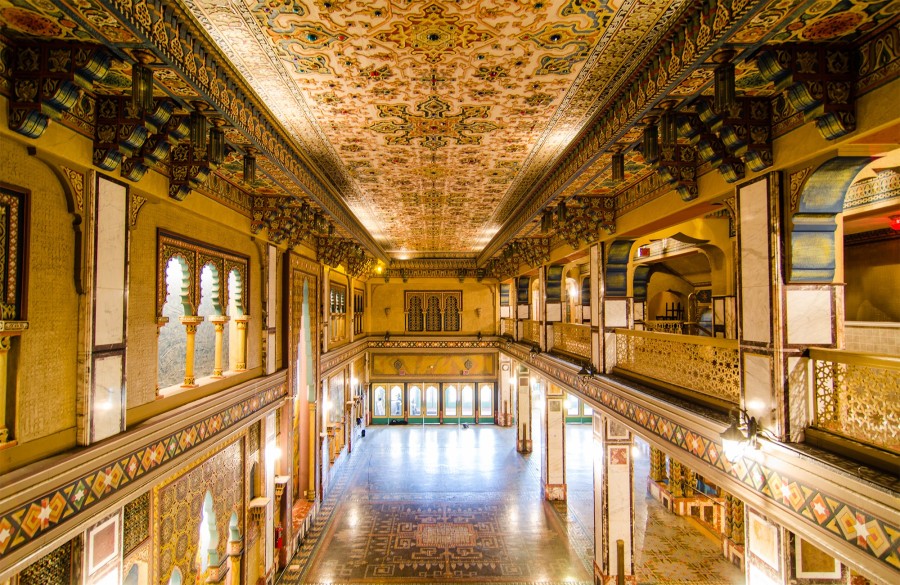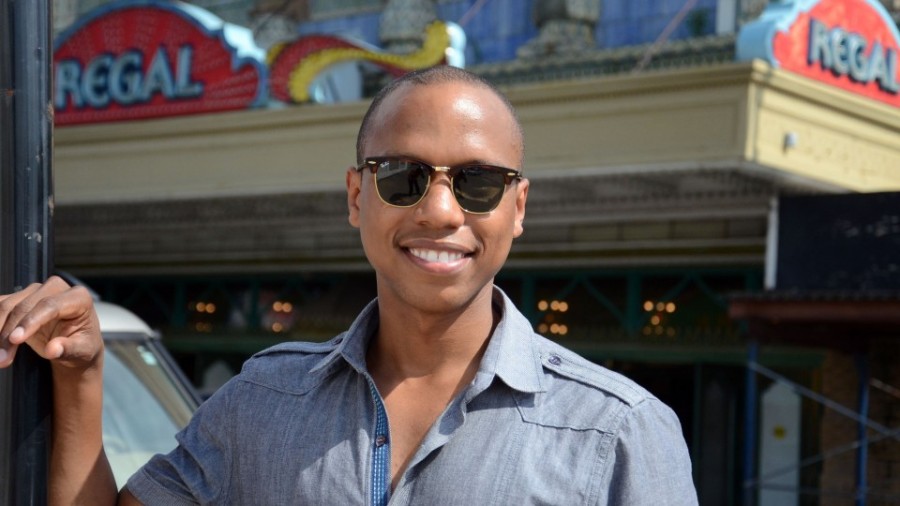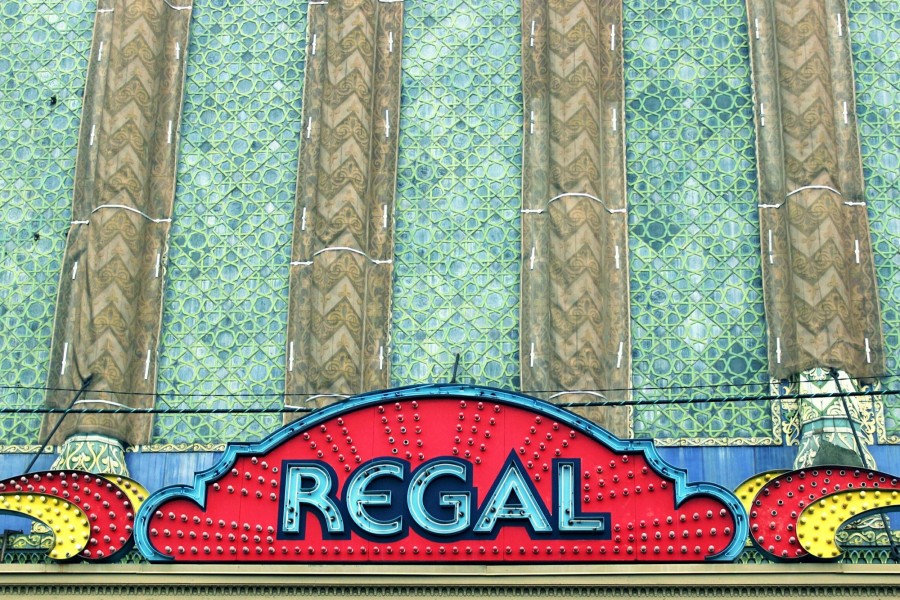

The Avalon Regal Theater was once a luxurious movie palace. Today, its future is uncertain.
The theater in South Shore has almost a century of cultural significance. Since 2003, it’s sat mostly empty. What will happen to it?
Eleanor Truex lives in south suburban Flossmoor and occasionally, when traffic is especially bad, she gets off the highway and takes a detour through city streets. On that route, she passes by a building on 79th Street in the South Shore neighborhood that looks like it belongs on a movie set.

Truex reached out to Curious City wanting to know more about this extraordinary building, and if there are any efforts underway to preserve it.
The building Truex is talking about is the Avalon Regal Theater built in the 1920s as an eclectic entertainment venue.
This old theater has had many different names and different lives over the years. Less than a decade after opening it moved away from live performances to primarily show films.
The Avalon Regal Theater closed its doors to the public in 2003 for a number of reasons, including low attendance and high maintenance costs. Since then there have been a few notable events in the theater, like Obama’s election night party to celebrate his first presidential victory. And it’s a regular stop on the Chicago Architecture Center’s annual Open House Chicago tours.
Several owners have tried to restore the building to its past grandeur including its current owner Jerald Gary of Community Capital Investment LLC. Gary’s dream is to transform the space into a hub of art and culture on 79th Street.
“I’m taken aback every time I enter the building and I notice something new every time I walk into the building,” says Gary, who grew up near the theater.
But getting the Avalon Regal to reopen has been a real saga. His ownership of the theater is currently hanging by a thread.

An “atmospheric” design
Built in 1927, the theater was known as the Avalon Theater. Architect John Eberson, a leader of “atmospheric” theater style, designed this building to make people feel like they were immersed in a magical place. It was inspired by something he found at an antique store.
“He comes across an incense burner from Persia and he’s looking at this intricate metal work and all of the geometry and detail in this artifact,” Adam Rubin, director of interpretation at the Chicago Architecture Center, says. “That was part of the inspiration.”

The floor-to-ceiling mosaics and decorative latticework give the building a glamorous touch. The ceiling above the main lobby looks like a flying carpet with embedded colorful rocks that sparkle giving people the impression that they are in a movie set. “It’s kind of something that has a kitsch factor before we use the term kitsch factor,” Rubin says.
The auditorium, where the main stage is, has about 2,300 velvet seats in rows across the first floor and balcony. The awning above the stage evokes a circus tent and gives visitors the impression that they are camped out under the stars.

When Eberson was designing this building, people were moving into large cities like Chicago from the south and other countries in Europe. The area where the South Shore neighborhood is was predominantly German, Swedish and Irish.
Many residents were processing what they’d seen during World War I, Rubin explains. The Americans who fought in Europe saw the destruction of Gothic churches and other historic architecture. Rubin says that creating theaters like the Avalon Regal was a way for architects and builders to process trauma of the war, but also to celebrate the things that they hadn’t seen in American architecture yet.
From live animal acts to Westerns (1920s-1960s)
The theater’s design was also part of larger trends happening at the time. “Because the big theaters were so important, the major companies made them opulent to attract patrons, not simply through the films being shown but through the promise of an exciting moviegoing experience,” write Kristin Thompson and David Bordwell in their book Film History: An Introduction. “The architecture of the picture palaces gave working- and middle-class patrons an unaccustomed taste of luxury.”
According to advertisements in the Chicago Daily Tribune, the theater showed films and live stage performances in its early years. For example, one advertisement from 1929 announces a screening of the Western film In Old Arizona along with stage performances by singer Roy Detrich and vaudeville performer Charlie Crafts.

And in 1935, the theater hosted vaudeville entertainer “Little Jackie” Heller, a live animal act featuring Proske’s Royal Bengal Tigers and a screening of the film Imitation of Life, according to one advertisement.
By the 1940s, the theater shifted to showing almost exclusively films, according to archival newspaper articles and advertisements from the Chicago Daily Tribune and the Chicago Defender, showing everything from musical comedies to adventure war films.
A regal rebirth (1980s-2000s)
After a brief stint as a church in the early 1980s, the theater took on a new life once again.
That’s when Soft Sheen business owners Edward and Bettiann Gardner purchased and poured lots of money into the theater to revive it as a cultural gathering space. By this time, the neighborhood around 79th Street was mostly home to African American residents.

The Gardners renamed the venue the New Regal Theater in honor of a popular music spot in Bronzeville that had been torn down. The building was designated a Chicago landmark in 1992.
Robert Howell, who is in his 50s and is the theater’s current caretaker, grew up in this area. He remembers the thrill of attending events during this time period.
“Every time we came here was a new adventure,” Howell says. “Every time I came here was somebody iconic that I wanted to see.”
That includes Tyler Perry and George Clinton. “Each point of the navigation is an experience,” Howell says. “Coming to the ticket booth sitting under the awning. It’s all the glitz. And it’s just something I’ve never even seen before, not even on TV.”

After 18 years of live shows that featured performers like Gladys Knight and the Pips, Patti LaBelle and Tupac, the Gardners closed the theater in 2003. Attendance had been dwindling for years as residents left the neighborhood and businesses shut down. Since then, the building has sat mostly dormant.
The theater’s uncertain future
Jerald Gary has been on a mission to reopen the Avalon Regal Theater since he purchased it for $100,000 in 2014. He believes the closure of the theater played a big role in the decline of the neighborhood.
“The area was bustling when the theater was open,” he says. “As you can imagine, there were a number of different businesses that rely on the building being in operation. And at this time on the block, the only business that is open is a liquor store.”
Gary’s vision is to help turn 79th Street into a version of Beale Street, the popular entertainment district in Memphis known as the home of the blues. He also wants the theater to be an arts community center.

But buying the building and dreaming about the possibilities is the easy part.
These days Gary’s been tackling one issue after the other, including renovations, repairs and meeting building code requirements. It’s a lot more difficult to restore an old theater than to build a new one, says Jerry Mickelson, who runs the Riviera and Vic theaters. Mickelson has been trying to reopen the Uptown Theatre, a 1920s jewel on the North Side, but it’s been challenging.
In general, rehabbing old theaters is complicated. First, you have to tally all of the costs for electrical, plumbing, elevators, air conditioning and heat. Then comes the city’s permitting process. And then you have to raise all of the money, he says.
Gary has had a similar experience at the Avalon Regal Theater. He’s been working to raise funds for years with some success including about $600,000 from rapper Ye, formerly known as Kanye West. He’s also received federal funds under the Payment Protection Program and rental fees from production companies that have filmed there.

But none of that is enough to pay for monthly upkeep or the investments the building requires. That, and the hundreds of thousands of dollars he owes to Cook County in back property taxes. If he doesn’t pay soon he could lose the building.
He says funding is hard to come by, especially in predominantly Black neighborhoods.
“I think the stigma is … a negative perception that people have on investing in Black communities, except for Black people themselves,” Gary says. “And even at times, there are folks who live in the community that because of the despair they see … and all of the boarded up businesses, [they] want to give up.”

That same corridor on 79th Street that Gary wants to help revitalize has also been selected by the city as an area for investment. But, so far, this hasn’t been a boon for the future of the theater.
The city has turned down several applications from Gary for assistance. In an email to Curious City, Peter Strazzabosco, Deputy Commissioner of the Chicago Department of Planning and Development, wrote, “Priority is given to proposals that demonstrate a high level of project readiness, ownership experience, private financing, and other factors.”
Despite all of the challenges, Gary remains committed to this celebrated but time-worn theater.
Mickelson says that he’s been following Jerald’s saga, and that there should be more support for old theaters like the Avalon Regal.
“Our buildings are the art that we’re trying to preserve,” Mickelson says. “And it’s not art hanging on a wall. It’s art in a ceiling, it’s art in a floor. It’s art in the way the washrooms are designed, it’s art in any aspect of these beautiful old movie palaces.”
Adriana Cardona-Maguigad is Curious City’s reporter. Follow her @AdrianaCardMag
More From
Curious City


The Avalon Regal Theater was once a luxurious movie palace. Today, its future is uncertain.
The theater in South Shore has almost a century of cultural significance. Since 2003, it’s sat mostly empty. What will happen to it?
Eleanor Truex lives in south suburban Flossmoor and occasionally, when traffic is especially bad, she gets off the highway and takes a detour through city streets. On that route, she passes by a building on 79th Street in the South Shore neighborhood that looks like it belongs on a movie set.

Truex reached out to Curious City wanting to know more about this extraordinary building, and if there are any efforts underway to preserve it.
The building Truex is talking about is the Avalon Regal Theater built in the 1920s as an eclectic entertainment venue.
This old theater has had many different names and different lives over the years. Less than a decade after opening it moved away from live performances to primarily show films.
The Avalon Regal Theater closed its doors to the public in 2003 for a number of reasons, including low attendance and high maintenance costs. Since then there have been a few notable events in the theater, like Obama’s election night party to celebrate his first presidential victory. And it’s a regular stop on the Chicago Architecture Center’s annual Open House Chicago tours.
Several owners have tried to restore the building to its past grandeur including its current owner Jerald Gary of Community Capital Investment LLC. Gary’s dream is to transform the space into a hub of art and culture on 79th Street.
“I’m taken aback every time I enter the building and I notice something new every time I walk into the building,” says Gary, who grew up near the theater.
But getting the Avalon Regal to reopen has been a real saga. His ownership of the theater is currently hanging by a thread.

An “atmospheric” design
Built in 1927, the theater was known as the Avalon Theater. Architect John Eberson, a leader of “atmospheric” theater style, designed this building to make people feel like they were immersed in a magical place. It was inspired by something he found at an antique store.
“He comes across an incense burner from Persia and he’s looking at this intricate metal work and all of the geometry and detail in this artifact,” Adam Rubin, director of interpretation at the Chicago Architecture Center, says. “That was part of the inspiration.”

The floor-to-ceiling mosaics and decorative latticework give the building a glamorous touch. The ceiling above the main lobby looks like a flying carpet with embedded colorful rocks that sparkle giving people the impression that they are in a movie set. “It’s kind of something that has a kitsch factor before we use the term kitsch factor,” Rubin says.
The auditorium, where the main stage is, has about 2,300 velvet seats in rows across the first floor and balcony. The awning above the stage evokes a circus tent and gives visitors the impression that they are camped out under the stars.

When Eberson was designing this building, people were moving into large cities like Chicago from the south and other countries in Europe. The area where the South Shore neighborhood is was predominantly German, Swedish and Irish.
Many residents were processing what they’d seen during World War I, Rubin explains. The Americans who fought in Europe saw the destruction of Gothic churches and other historic architecture. Rubin says that creating theaters like the Avalon Regal was a way for architects and builders to process trauma of the war, but also to celebrate the things that they hadn’t seen in American architecture yet.
From live animal acts to Westerns (1920s-1960s)
The theater’s design was also part of larger trends happening at the time. “Because the big theaters were so important, the major companies made them opulent to attract patrons, not simply through the films being shown but through the promise of an exciting moviegoing experience,” write Kristin Thompson and David Bordwell in their book Film History: An Introduction. “The architecture of the picture palaces gave working- and middle-class patrons an unaccustomed taste of luxury.”
According to advertisements in the Chicago Daily Tribune, the theater showed films and live stage performances in its early years. For example, one advertisement from 1929 announces a screening of the Western film In Old Arizona along with stage performances by singer Roy Detrich and vaudeville performer Charlie Crafts.

And in 1935, the theater hosted vaudeville entertainer “Little Jackie” Heller, a live animal act featuring Proske’s Royal Bengal Tigers and a screening of the film Imitation of Life, according to one advertisement.
By the 1940s, the theater shifted to showing almost exclusively films, according to archival newspaper articles and advertisements from the Chicago Daily Tribune and the Chicago Defender, showing everything from musical comedies to adventure war films.
A regal rebirth (1980s-2000s)
After a brief stint as a church in the early 1980s, the theater took on a new life once again.
That’s when Soft Sheen business owners Edward and Bettiann Gardner purchased and poured lots of money into the theater to revive it as a cultural gathering space. By this time, the neighborhood around 79th Street was mostly home to African American residents.

The Gardners renamed the venue the New Regal Theater in honor of a popular music spot in Bronzeville that had been torn down. The building was designated a Chicago landmark in 1992.
Robert Howell, who is in his 50s and is the theater’s current caretaker, grew up in this area. He remembers the thrill of attending events during this time period.
“Every time we came here was a new adventure,” Howell says. “Every time I came here was somebody iconic that I wanted to see.”
That includes Tyler Perry and George Clinton. “Each point of the navigation is an experience,” Howell says. “Coming to the ticket booth sitting under the awning. It’s all the glitz. And it’s just something I’ve never even seen before, not even on TV.”

After 18 years of live shows that featured performers like Gladys Knight and the Pips, Patti LaBelle and Tupac, the Gardners closed the theater in 2003. Attendance had been dwindling for years as residents left the neighborhood and businesses shut down. Since then, the building has sat mostly dormant.
The theater’s uncertain future
Jerald Gary has been on a mission to reopen the Avalon Regal Theater since he purchased it for $100,000 in 2014. He believes the closure of the theater played a big role in the decline of the neighborhood.
“The area was bustling when the theater was open,” he says. “As you can imagine, there were a number of different businesses that rely on the building being in operation. And at this time on the block, the only business that is open is a liquor store.”
Gary’s vision is to help turn 79th Street into a version of Beale Street, the popular entertainment district in Memphis known as the home of the blues. He also wants the theater to be an arts community center.

But buying the building and dreaming about the possibilities is the easy part.
These days Gary’s been tackling one issue after the other, including renovations, repairs and meeting building code requirements. It’s a lot more difficult to restore an old theater than to build a new one, says Jerry Mickelson, who runs the Riviera and Vic theaters. Mickelson has been trying to reopen the Uptown Theatre, a 1920s jewel on the North Side, but it’s been challenging.
In general, rehabbing old theaters is complicated. First, you have to tally all of the costs for electrical, plumbing, elevators, air conditioning and heat. Then comes the city’s permitting process. And then you have to raise all of the money, he says.
Gary has had a similar experience at the Avalon Regal Theater. He’s been working to raise funds for years with some success including about $600,000 from rapper Ye, formerly known as Kanye West. He’s also received federal funds under the Payment Protection Program and rental fees from production companies that have filmed there.

But none of that is enough to pay for monthly upkeep or the investments the building requires. That, and the hundreds of thousands of dollars he owes to Cook County in back property taxes. If he doesn’t pay soon he could lose the building.
He says funding is hard to come by, especially in predominantly Black neighborhoods.
“I think the stigma is … a negative perception that people have on investing in Black communities, except for Black people themselves,” Gary says. “And even at times, there are folks who live in the community that because of the despair they see … and all of the boarded up businesses, [they] want to give up.”

That same corridor on 79th Street that Gary wants to help revitalize has also been selected by the city as an area for investment. But, so far, this hasn’t been a boon for the future of the theater.
The city has turned down several applications from Gary for assistance. In an email to Curious City, Peter Strazzabosco, Deputy Commissioner of the Chicago Department of Planning and Development, wrote, “Priority is given to proposals that demonstrate a high level of project readiness, ownership experience, private financing, and other factors.”
Despite all of the challenges, Gary remains committed to this celebrated but time-worn theater.
Mickelson says that he’s been following Jerald’s saga, and that there should be more support for old theaters like the Avalon Regal.
“Our buildings are the art that we’re trying to preserve,” Mickelson says. “And it’s not art hanging on a wall. It’s art in a ceiling, it’s art in a floor. It’s art in the way the washrooms are designed, it’s art in any aspect of these beautiful old movie palaces.”
Adriana Cardona-Maguigad is Curious City’s reporter. Follow her @AdrianaCardMag











